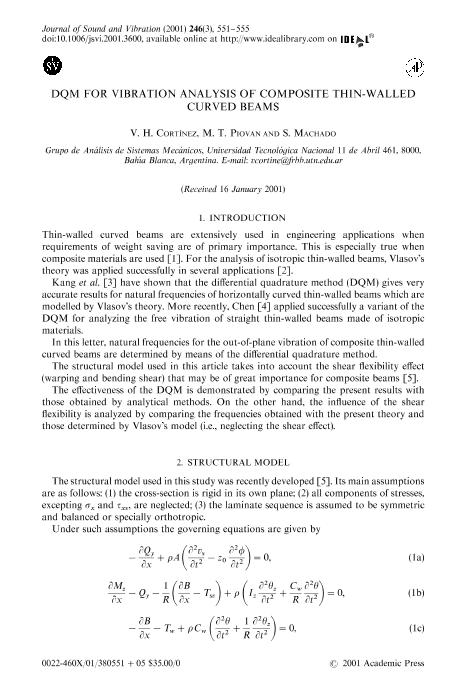Artículo
DQM for vibration analysis of composite thin-walled curved beams
Fecha de publicación:
09/2001
Editorial:
Academic Press Ltd - Elsevier Science Ltd
Revista:
Journal of Sound and Vibration
ISSN:
0022-460X
Idioma:
Inglés
Tipo de recurso:
Artículo publicado
Clasificación temática:
Resumen
Thin-walled curved beams are extensively used in engineering applications when requirements of weight saving are of primary importance. This is especially true when composite materials are used. For the analysis of isotropic thin-walled beams, Vlasov's theory was applied successfully in several application. Kang et al. have shown that the differential quadrature method (DQM) gives very accurate results for natural frequencies of horizontally curved thin-walled beams which are modelled by Vlasov's theory. More recently, Chen applied successfully a variant of the DQM for analyzing the free vibration of straight thin-walled beams made of isotropic materials. In this letter, natural frequencies for the out-of-plane vibration of composite thin-walled curved beams are determined by means of the differential quadrature method. The structural model used in this article takes into account the shear flexibility effect (warping and bending shear) that may be of great importance for composite beams. The effectiveness of the DQM is demonstrated by comparing the present results with those obtained by analytical methods. On the other hand, the influence of the shear flexibility is analyzed by comparing the frequencies obtained with the present theory and those determined by Vlasov's model (i.e., neglecting the shear effect).
Palabras clave:
Diferential Quadrature Method
,
Thin-Walled Beams
Archivos asociados
Licencia
Identificadores
Colecciones
Articulos(CCT - BAHIA BLANCA)
Articulos de CTRO.CIENTIFICO TECNOL.CONICET - BAHIA BLANCA
Articulos de CTRO.CIENTIFICO TECNOL.CONICET - BAHIA BLANCA
Citación
Cortínez, Víctor Hugo; Piovan, Marcelo Tulio; Machado, Sebastián Pablo; DQM for vibration analysis of composite thin-walled curved beams; Academic Press Ltd - Elsevier Science Ltd; Journal of Sound and Vibration; 246; 3; 9-2001; 551-555
Compartir
Altmétricas




